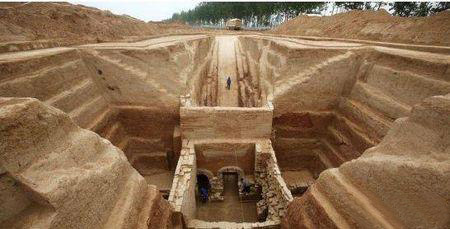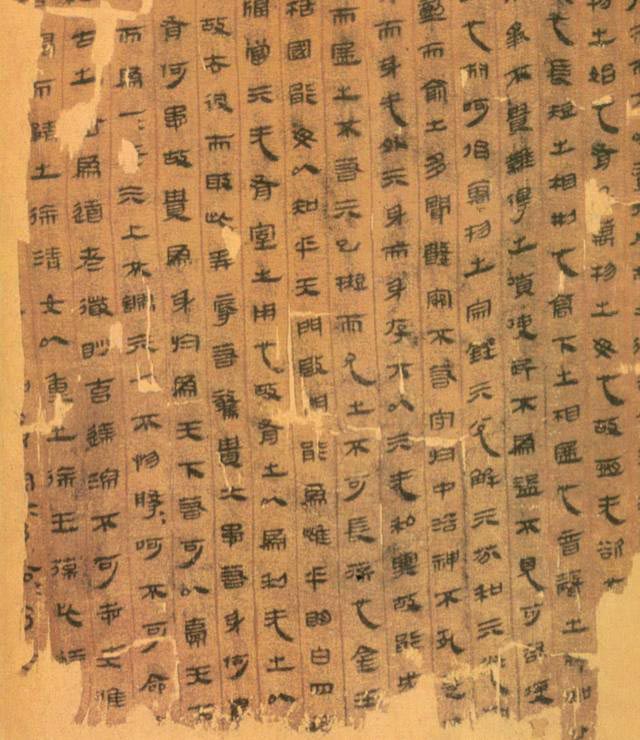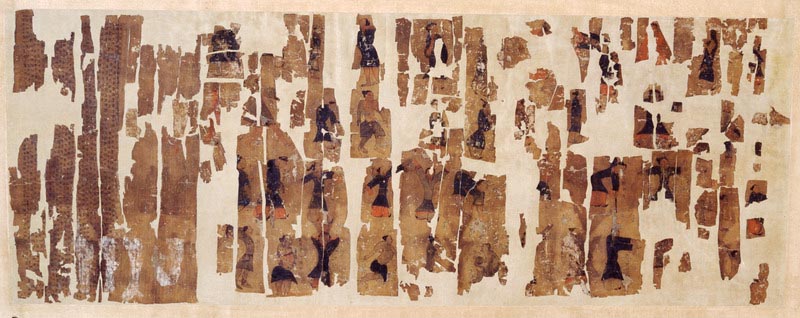Introduction
In 1973, a silk roll with drawings that resemble the exercises we know today as Qìgōng 氣功 was unearthed in Mǎwángduī 馬王堆, Húnán 湖南 Province. This scroll was found in a tomb of the Hàn 漢 dynasty and dates from 168 BC. It is known as Dǎoyǐntú 導引圖.
Dǎoyǐn 導引 is a term that designates a series of psychophysical exercises performed as a way to cultivate internal energy, and which precede the modern practice of Qìgōng.
The Mawangdui texts
Mǎwángduī is the name given to the archaeological site where the tombs of three people from the ancient Kingdom of Chángshā (長沙國 Chángshā Guó) are located, in Húnán.
The name Mǎwángduī 馬王堆, "tumulus of King Mǎ", probably comes from a mis assignment of the main tomb to Mǎ Yīn 馬殷, ruler of the kingdom of Chǔ楚. Actually, the tombs belong to the minister Lì Cāng 利蒼, his wife Xīn Zhuī 辛追, and another male who is believed to be one of their sons, and possibly the original name may have been Mǎānduī 馬鞍堆, "saddle[-shaped] tumulus".

Mǎwángduī 馬王堆 tombs.
The tombs were discovered in 1971 and began excavation the following year, completing the excavation in 1974. Among the objects unearthed in these tombs are the so-called Mǎwángduī texts (馬王堆帛書 Mǎwángduī Bóshū), a collection of manuscripts written mostly on silk that deal with a wide variety of subjects. Among them are some of the oldest copies ever found of classical texts such as the Dàodé Jīng 道德經 or the Yì Jīng 易經, as well as treatises on astronomy, history, geography, military strategy, mathematics, horsemanship, archery, philosophy and medicine.
The Mǎwángduī texts were found in tomb number 3 of the site, which belonged to a man in his thirties, possibly one of the sons of Lì Cāng. This tomb also housed a large number of weapons, suggesting that its occupant held a military position.
It is believed that these texts belonged to the deceased during his life. Possibly they were texts of which the deceased would make regular use, and therefore were selected to accompany him to the afterlife, where they would continue to be useful.
The ability to read shows that the occupant belonged to the educated upper class; moreover, the possession of a personal library, from which it is believed that these texts were selected, is a sign of high social rank. In addition, the material on which most of these texts are written, silk, reflects the economical power of their owner since, unlike bamboo, in which a writing error could be scrapped and rewritten, an error on silk could not be corrected. This required great skill on the part of the scribes and made the final price of the product more expensive.

After more than two thousand years underground, the manuscripts were very deteriorated, most fragmented, and have been recomposed with much effort, although they are not legible in their entirety.
Among the texts devoted to medicine is the illustration known as Dǎoyǐntú, which we can translate as "illustration of [the methods of] conduction of energy".
The Daoyintu
Dǎoyǐn is the name given to the ancient practice of physical and respiratory exercises that preceded Qìgōng, and whose goeal is to harmonize mind and body, harmonize internal and external environments and prolong health and longevity.
Literally, the term dǎoyǐn translates as "to guide and pull", and in conjunction it refers to the methods of conduction of internal energy through the body through physical movement, intention (意 yì), and breathing.
Although the term dǎoyǐn is applied to refer to this illustration and the exercises depicted in the Dǎoyǐntú, this term originated much later, and in the Mǎwángduī texts these methods are referred to simply as yǐn 引, which at that time was used to refer to the physical methods of elimination of pathogenic factors.
In the Dǎoyǐntú are represented 44 human figures performing physical exercises of energy conduction. Each figure represents a different exercise with a specific purpose. The original scroll was found in an advanced state of deterioration, and most of the images, as well as the accompanying descriptions, are not complete and/or legible. However, the researchers have been able to reconstruct the scroll until a recreation of all the figures was achieved.
The same has not happened with the annotations that accompany the illustrations, of which only twenty-five have been saved. These annotations refer to the name of the exercise or its purpose. Some of the exercises imitate the spirit of certain animals such as the crane, the monkey, the mantis or the bear; others require the use of objects such as sticks or medicinal sacks.

The original Dǎoyǐntú 導引圖.

Reconstruction of the Dǎoyǐntú.
Among the 44 exercises depicted, some are remarkably reminiscent of certain movements of the Bāduànjǐn 八段錦 or Eight Pieces of Silk Brocade, suggesting that some exercises included in this series might have a very ancient origin.
Other medical texts
Together with the Dǎoyǐntú, there were in the tombs of Mǎwángduī other texts relating to the maintenance of health. Of these texts it is worth highlighting some interesting facts.
First, the texts only refer to eleven energy meridians, instead of the twelve main channels with which Chinese Medicine operates today. In addition, the nomenclature that is made of these channels does not coincide with the current nomenclature, which designates the meridians in relation to the internal organs (for example, "Gallbladder Channel of Foot Shǎo Yáng", 足少陽膽經 zú shǎo yáng dǎn jīng). Instead, the meridians are referred to only as "Foot Shǎo Yáng" (足少陽 zú shǎo yáng), etc.
On the other hand, and although the energy meridians are referred to, no acupuncture methods or points are described, which could be indicative that the theoretical basis of acupuncture had not yet been fully developed at that time, contrary to what is usually believed. In this sense, V. Shaw suggests that the medical texts of Mǎwángduī would form the basis on which acupuncture would develop in the following centuries.
Finally, the inclusion of the description of the energy channels in the same set of texts that includes the Dǎoyǐntú, suggests that for the realization of the exercises described in the latter it was necessary to know about the circulation of energy through these channels or meridians.
Conclusion
Thanks to the discovery of the Dǎoyǐntú and the Mǎwángduī texts, we have evidence of the antiquity of these methods of energetic conduction, which form the basis of current Qìgōng. The little change that these methods have undergone over more than two thousand years is indicative of their high degree of development already in the Hàn era, as well as their effectiveness, and reveal the importance that the cultivation of health has had for the Chinese since time immemorial.
Sources:
Shaw, V., & Mclennan, A. K. (2016). Was acupuncture developed by Han Dynasty Chinese anatomists? Anatomical record: Advances in Integrative Anatomy and Evolutionary Biology , 299 (5), 643-59.
Shaw, V., Diogo, R., & Winder, I. C. (2020). Hiding in Plain Sight-Ancient Chinese Anatomy. Anatomical record: Advances in Integrative Anatomy and Evolutionary Biology.

2 thoughts on “The Daoyintu and the Mawangdui Texts”
Hello, I enjoyed reading your short article on this subject. In July 2022 my colleague and I published a book with Three Pines Press, called “Shadows of Mawangdui”. The intent of the book is to bring the daoyintu images to life and provide insight into the art of guiding and pulling. If you wish to discuss any aspect of this, you have my email. Sincerely,
Ron Smith
Hi Mr. Smith,
Thanks for your appreciation, and for sharing about your work!
Sounds really interesting, and we’ll definitely try to fetch a copy of it.
Thank you for your kindness.
Regards,
Juan